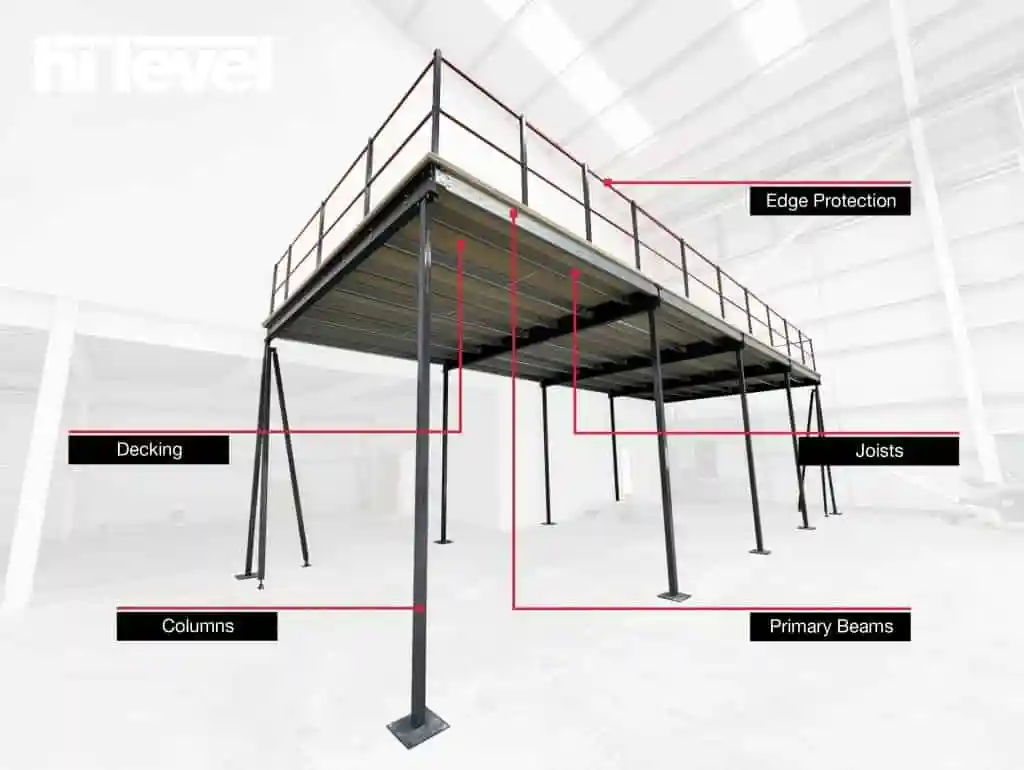Thinking about adding a mezzanine level to your building? It’s a savvy way to unlock extra square footage, but before you start picturing that stylish new office space or workshop, let’s talk about a crucial factor: mezzanine floor height. Getting this right is the key to a safe, functional, and code-compliant structure.
Mezzanine Floor Height: Finding the Sweet Spot Between Space and Safety
Building codes often feel like a maze of regulations, but understanding the reasoning behind them can simplify the process. When it comes to mezzanine floor heights, these regulations exist to ensure safety, accessibility, and structural integrity.
Headroom Matters: Minimum Height Requirements
Picture this: you’re constantly ducking and weaving to avoid hitting your head on the ceiling of your new mezzanine. Not ideal, right? Building codes agree and mandate a minimum clear height of 7 feet between the mezzanine floor and the ceiling above to ensure comfortable headroom for everyone. Additionally, there’s usually a minimum height requirement of 14.7 feet from the ground floor to the mezzanine ceiling for emergency clearance, ventilation, and lighting.
Open Space, Safe Space: Clearance and Accessibility
A cramped mezzanine is not only uncomfortable but also a safety hazard. Adequate clearance is crucial, so aim for at least 7 feet of clear height both above and below the mezzanine for safe movement and easy transport of furniture and equipment.
Accessibility is another vital factor. Think about how people will access the mezzanine – stairs, a ramp, or even a small elevator? Factor in the space needed for these access points when planning your mezzanine’s height.
Size It Right: Area Limitations
While maximizing space might seem tempting, safety and structural integrity are non-negotiable. Building codes typically limit mezzanine area to one-third of the floor space it occupies. This restriction ensures the existing floor can handle the additional load and maintains a sense of openness in the space.
Design with Purpose: Aesthetics Meet Functionality
Mezzanine design hinges on finding that perfect balance between practicality and visual appeal. Beyond meeting the height requirements, consider these elements:
- Access methods: Stairs are common, but a ramp may be necessary for accessibility. Larger mezzanines might benefit from a small elevator. Choose an access method that’s safe, convenient, and complements your design.
- Load-bearing capabilities: Consider your mezzanine’s intended use. Heavy machinery necessitates a more robust structure than an office space. A structural engineer can help you determine the necessary load-bearing capacity and ensure your mezzanine height doesn’t compromise its strength.
- Visual integration: Your mezzanine should enhance, not overpower, your existing space. Carefully consider materials, colors, and lighting to create a cohesive and visually appealing environment.
Don’t Cut Corners: Code Compliance
Building codes might seem like a hassle, but they’re in place to keep everyone safe. Adhering to codes like the International Building Code (IBC) and Occupational Safety and Health Administration (OSHA) regulations, especially when it comes to mezzanine floor height, is essential.
Cutting corners on code compliance can lead to serious consequences:
- Safety hazards: An improperly designed mezzanine could collapse, putting people at risk.
- Legal repercussions: Failing to meet building codes can result in hefty fines or even legal action.
Designing your mezzanine with code compliance in mind from the get-go prevents these issues and ensures a safe, functional space.
Beyond the Basics: Unique Considerations
Here are a few additional tips to make your mezzanine stand out:
- Sustainability: Opt for eco-friendly materials like reclaimed wood or bamboo flooring. Incorporate energy-efficient lighting and ventilation systems to minimize environmental impact.
- Customization: Embrace creativity! Explore adjustable height options for added flexibility. Consider custom configurations to meet your specific needs, whether it’s built-in shelving, specialized workspaces, or unique design elements.
- Emerging Technologies: Take your mezzanine to the next level by integrating automated materials handling systems. These systems can boost efficiency and streamline workflow, especially for businesses dealing with inventory or manufacturing.
By carefully considering these factors and collaborating with experienced professionals, you can create a mezzanine that not only meets your functional needs but also elevates the style and value of your property.
If you are looking for the best mezzanine floor to optimize your space, then you’ve come to the right place. This is specially designed to create an additional level within an existing building, providing extra space for various purposes.
What are Mezzanine Floor Height Regulations?
Mezzanine floor height regulations, primarily outlined by organizations like OSHA and the IBC, are put in place to guarantee the safety and functionality of these structures.
Headroom and Safety
One of the key aspects these regulations address is headroom. A minimum height requirement of around 7 feet, both above and below the mezzanine floor, ensures people can move comfortably and operate equipment without risking head injuries.
Space Optimization and Flow
These regulations also consider space utilization. Typically, mezzanines can’t occupy the entire floor area below. There’s usually a limit, often around one-third of the total floor space, to prevent overcrowding, maintain airflow, and ensure easy evacuation in emergencies.
Importance of Compliance
Imagine a cramped, poorly designed mezzanine with barely enough headroom. Not only is it uncomfortable, but it also poses significant safety risks, especially when moving equipment around. Sticking to height regulations ensures a space that’s both practical and safe for everyone, from those working on the mezzanine to those on the ground floor.
How High Can a Mezzanine Be?
While you might have grand visions of a towering mezzanine, building codes, specifically the International Building Code (IBC), dictate the maximum height for safety reasons.
IBC Guidelines for Height
The IBC, along with OSHA regulations, sets guidelines for how high you can build your mezzanine, primarily to ensure adequate headroom and safety in emergencies. These guidelines often include a minimum of seven feet of clear space both above and below the mezzanine for comfortable movement and airflow.
Area Restrictions
The IBC also restricts the area a mezzanine can occupy, typically limiting it to about one-third of the room’s floor area. This limitation prevents the mezzanine from overwhelming the space and maintains a sense of openness on the ground level.
Structural Considerations
The maximum height of your mezzanine also depends on structural factors. The amount of weight it needs to support (the “floor loading”), how much it might deflect under pressure, and fire safety measures like sprinklers all contribute to determining the appropriate height.
Customizing Within Limits
While building codes set the boundaries, you still have room for creativity. Collaborating with a skilled architect or engineer allows you to customize the height, shape, and materials of your mezzanine to match your space and its intended use while staying compliant with safety regulations.
For a deeper dive into the specifics of building codes, you can check out the International Building Code (IBC) here: https://codes.iccsafe.org/content/IBC2021.
Maximizing Space: The Benefits of Mezzanine Floors
Mezzanine floors are like space-saving superheroes, providing a cost-effective and versatile solution for maximizing your existing square footage.
For those who are interested in constructing their own mezzanine floor, we have a comprehensive guide that covers everything you need to know, from planning and design to materials and installation.
Unlocking Vertical Space
Mezzanines capitalize on the unused vertical space in a building, essentially adding an extra floor without the need for costly additions or relocation. This is especially beneficial for businesses experiencing rapid growth or those working within a limited footprint.
Budget-Friendly Expansion
Compared to building an addition, mezzanine floors are a much more budget-friendly option for expanding your space. The materials and construction are typically less expensive, and you’ll save on utilities because you’re not increasing the building’s overall footprint.
Boosting Productivity and Workflow
Mezzanines do more than just add space; they can also enhance productivity. By creating dedicated zones for different tasks, you can streamline operations and improve workflow. For example, designating a mezzanine level for storage frees up valuable space on the main floor for other activities.
For those looking for a durable and efficient industrial mezzanine floor solution, we have a wide range of options to meet your specific requirements. These floors are engineered to withstand heavy loads and are ideal for warehouses, factories, and other industrial settings.
Visual Appeal and Openness
Beyond their practical benefits, mezzanines also enhance the aesthetic appeal of a space. They create visual interest, break up the monotony of a single floor, and can even improve natural light penetration. This makes your space feel larger, more inviting, and less cramped.
If you are located in the United States and looking for a reliable mezzanine floor system provider, we have a team of experts ready to assist you. We offer a full range of services, from design and engineering to installation and maintenance.
Mezzanine floors offer a versatile solution for maximizing space and transforming the look and feel of your building, whether you’re a homeowner looking to add a cozy loft area or a business owner aiming to expand operations.
- Greenhouse Storage Shed Combos: Your Guide to Combining Growing and Storage - April 21, 2025
- Greenhouse Shed Combo: Design, Build & Grow Year-Round - April 21, 2025
- Gingham vs. Plaid: What’s the Difference? A Complete Guide - April 21, 2025










